Our view at Stack - Simplify growth with an all-in-one platform. Powerful marketing, sales, and support automation. Integrated CMS. Scalable software. Crafted for customer experience.
As someone who has experimented with different AI marketing tools, I can confidently say that embracing AI can benefit marketing teams looking to become more efficient in reaching their goals.
![Download Now: The Annual State of Artificial Intelligence in 2024 [Free Report]](https://no-cache.hubspot.com/cta/default/53/b72f2b25-8cc9-4642-9a1b-1e675d3d273b.png)
While it can automate tasks, save time and costs, and boost productivity, there are some AI challenges marketers should be aware of.
Our 2024 AI Trends report found that 74% of marketers predict most people will use AI in the workplace by 2030. So, I figured I should explore the challenges marketers could face when working with AI, so they’re prepared as it becomes a bigger part of their workflow.
I’ll also highlight expert insight from industry leaders so you can learn how to tackle these challenges and harness the power of AI in marketing.
Table of Contents
- The 10 Biggest Challenges When Implementing AI
- 12 Tips for Implementing AI
The 10 Biggest Challenges When Implementing AI
Along with the benefits of using AI in marketing outlined in the image below, the challenges of implementing AI in marketing are vast.
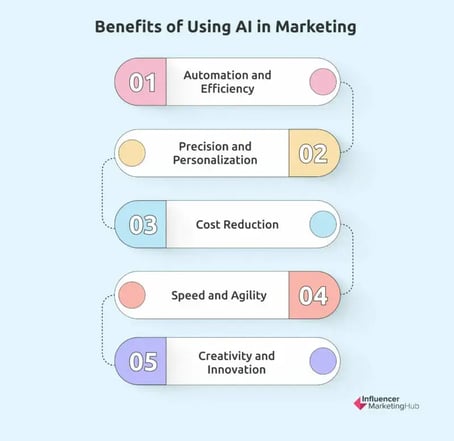
Image Source
This includes challenges related to the AI systems, processes, team buy-in, and more. We‘re working through the most significant challenges and the data that justifies these day-to-day challenges. You’re not the only one feeling the struggle.
Here are 10 common challenges when it comes to AI in marketing.
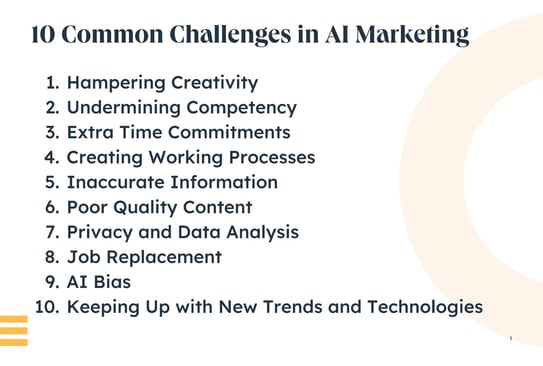
1. Hampering Creativity
As brands like Coca-Cola and mega-celebrities like Nicki Minaj use generative AI in their marketing campaigns, many marketers worry that AI could stifle creativity.
Our marketing and AI survey found that 43% of marketers who use AI do so to create content.
With such a huge chunk of marketers using AI to create, it’s understandable to have concerns that the marketing landscape could become oversaturated with AI and lose its creative spark.
However, there are several ways marketers can avoid this pitfall.
One key to overcoming the challenge is for marketers to use AI as an assistive tool that streamlines their process or gets the creative juices flowing.
2. Undermining Competency
If you‘re concerned that AI could undermine your competency as a marketer, you’re not alone.
According to our survey, 57% of marketers feel pressured to learn AI or risk becoming irrelevant. This translates to sentiments that AI could undermine a marketer’s effort and competency at work.
Though AI is becoming increasingly ingrained in marketing, that doesn‘t mean marketers can’t remain competitive and shine in the workplace.
Marketers can overcome this challenge by learning more about AI’s functionality, how different AI tools work, and finding ways AI can boost productivity or troubleshoot roadblocks.
3. Extra Time Commitments
If you want a sound output from AI, you need excellent input. That means you need to know what to ask for based on your goals.
Prompting AI for marketing is another thing to add to your swelling to-do list.
Like any new skill, prompting AI needs to be learned and practiced. The good news is that the time taken to prompt and use AI may be a case of short-term pain for long-term gain.
Based on our research, if you can prompt AI to deliver generative content that you’re happy to publish, you could save as much as three hours and ten minutes when working on a single piece of marketing content from start to finish. Not bad.
In fact, our survey found that 75% of marketers use AI to reduce the time they spend on manual tasks.
4. Creating Working Processes
A contributing factor to the challenge of time constraints when implementing AI is creating processes. However, navigating the challenges of AI will be easier with a working process.
If you use AI, you want all team members to work with it similarly. An AI process is required to help eliminate bias and ensure everything is fact-checked, and it naturally provides best practice tips to use AI tools efficiently.
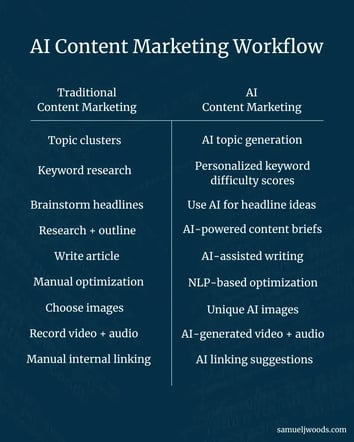
Image Source
5. Inaccurate Information
In our state of AI in marketing research, we found that one of the top challenges for marketers implementing AI is pushback regarding inaccurate information.
It’s unsurprising, considering almost half of the marketers surveyed have received incorrect information from generative AI.
Producing inaccurate information is undoubtedly a valid concern for conscientious marketers, and it could damage brand reputation and brand/consumer relations.
6. Poor Quality Content
Similar to the challenge above, poor-quality content concerns conscientious marketers. But there’s an argument that this does not need to be a challenge.
As I mentioned earlier, 43% of marketers in our survey use AI to create content.
With so many marketers leveraging AI in their creative processes, it‘s important to remember that AI isn’t always going to generate accurate results.
So, remember to fact-check AI outputs always.
7. Privacy and Data Analysis
There are broad concerns about privacy and data analysis regarding using AI.
When it comes to data analysis, marketers use AI to analyze customer data and understand user behavior. However, it has its own set of challenges. When implementing AI into your workflow or customer interactions, do the following:
- Consult with your supervisor and/or IT department before inputting sensitive data into AI.
- Be cautious of free trials, as they may retain your data after your trial is up.
- Choose trusted AI software with a proven track record of reliability and security.
8. Job Replacement
The worry about job replacement has been around for a while, and it’s understandable.
In 2017, a McKinsey report studied considerations around the workplace in 2030 and how AI might impact it.
The report estimated that “between 400 million and 800 million individuals could be displaced by automation and need to find new jobs by 2030.”
The good news is the findings are yet to come to fruition. In fact, our report finds the opposite to be true. According to our AI Trends Report, 68% of marketers surveyed say has helped grow their career.
But the fear is still there. You might find some pushback when implementing AI with your team if they’re worried about job security.
Now, the subject of job replacement and AI is much more positive. Mike Maynard, the CEO at Napier, published an article titled Will AI Lead To The End Of Marketing Jobs? in Forbes.
Maynard said, “AI will inevitably replace certain aspects of traditional marketing, but by and large, it will probably be the tedious, mundane tasks, like analytics, that most of us aren’t enthusiastic about anyway.”
He explained, “The truth is that although AI can potentially automate certain tasks and improve efficiency, it is unlikely to replace marketing teams for the foreseeable future completely.”
There are reasons to believe that AI is here to solve tasks and will never replace human teams in marketing. Naturally, marketing leaders must convince teams that their jobs are safe.
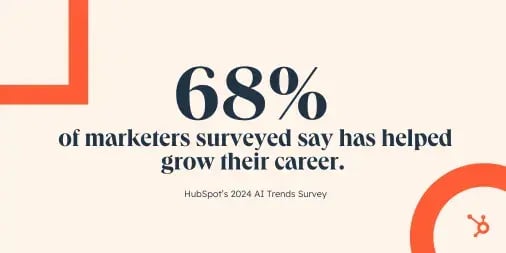
9. AI Bias
AI bias is a challenge that most marketers should be aware of.
Ultimately, AI will always be biased because humans are biased. Marketing leaders need a plan to meet the challenge of teams inputting bias into a system.
Bias is a serious consideration and challenge for businesses, and its impact can be serious. DataRobot’s 2022 survey found that the impact of data bias can result in as much as 62% lost revenue.
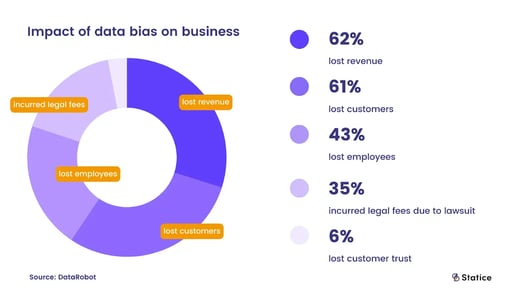
Image Source
10. Keeping Up with New Trends and Technologies
The field of AI is constantly evolving, and it’s growing fast. Marketers can feel overwhelmed keeping up with the latest trends and technologies.
It’s hard to know what to try, prioritize, and invest your time into. This challenge is particularly overwhelming if you have business heads pushing your team for more.
12 Tips for Implementing AI
Okay, now we know what some of the biggest challenges are, let’s find out how to overcome them in a way that helps you reach your marketing objectives while you reap all the AI benefits you’ve heard so much about.
Here are 12 tips to help you do just that.
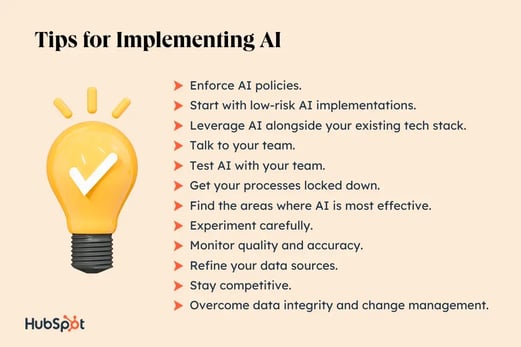
1. Enforce AI policies.
Dan Robinson, Head of Marketing and e-Commerce at instantprint, recommends that businesses implement and enforce AI policies to aid smooth AI implementation.
The solutions he‘s integrated into instantprint’s AI implementations include:
“Employees must adhere to the guidelines we‘ve set out. We nurture an environment of trust but also provide our team with the rules and regulations they need to be aware of to use these tools effectively and safely. Our ‘AI Code of Conduct’ is set out by each platform we use, with do’s and don’t for each tool.
“We want to make our AI policy a collaborative space. Those using AI and other models will get to know the platforms in great detail. Making policies a shared effort means that we’re more likely to have rules that will work for our team, developed by our team, with the exception of legal and ethical frameworks as a standard.”
What we like: Robinson doesn‘t deny the importance of AI policies that are legal and ethical but doesn’t stop the team from adding their thoughts. With a collaborative effort to develop policies, you’re more likely to get buy-in from team members.
2. Start with low-risk AI implementations.
Rosella Dello Ioio, Head of Content at Enate, says, “Businesses should be clearly defining the data they can and can’t share with public and private AI models. Consider hiring a Chief AI Officer to take the lead on security and governance within the business.
“Once the rules around these challenges have been clearly established, begin rolling out GenAI in your marketing department by identifying all the people whose job involves creating (writing, designing, and building) and let them find the best AI co-pilot for their tasks.
Creative roles such as Copywriting and Graphic Design are relatively low-risk in terms of sensitive data as opposed to a CRM Manager who wants to use GenAI to analyze customer feedback and complaints.
Test and procure low-risk tools to support these creative individuals in boosting productivity and slashing the time spent on mundane tasks while ensuring governance protocols are adhered to.”
What we like: It’s justified for marketers to be concerned about data and analysis by AI tools, but Dello Ioio has found a solution that allows marketing leaders to start implementing AI in a way that feels manageable and safe.
Sometimes, the first step is the most challenging, and once leaders get rolling with AI, they may be inspired to try more.
Look at HubSpot’s AI content assistant for low-risk AI experimentation. It’s free to demo, and you can write content, create emails, landing pages, and more.
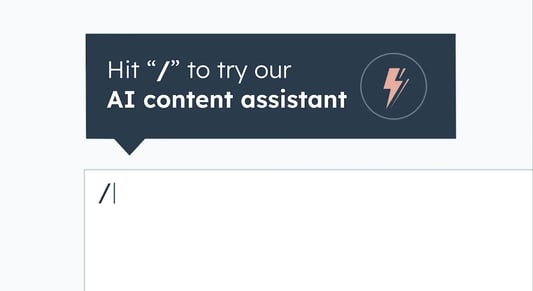
3. Leverage AI alongside your existing tech stack.
Cassey Bowden, Director of Marketing at Promet Source, recommends that marketing leaders consider new AI tools with existing tech and your talented team.
She says, “When used effectively in combination with other tools and skills of our respective teams, the door is wide open for possibilities. I would encourage folks to look at AI as an assistive tool in their digital toolbox.
Those who will see the best results and realize the most benefits of AI, in my opinion, will be those who view this tech through a Venn diagram lens.
Leveraging this tech along with your existing tech stack in addition to your skilled team, where these overlap, is where we will find success.”
What we like: Bowden’s tip could help marketing leaders close the gap on challenges that hamper creativity. If AI is used in addition to your skilled team, then there’s everything to gain through collaboration.
Consider taking the best of AI and the best of that all-important human touch and find the areas where they can best support each other.
4. Talk to your team.
Communication is, of course, everything! When it comes to AI, marketing leaders can eliminate a lot of AI challenges with team buy-in and communication.
Jessica Packard, Content Strategy Manager at ClockShark, found that some reassurance allowed her team to see AI for what it is; a marketing tool that can aid their workflow.
Packard says, “Initially, my team of copywriters was apprehensive about how AI could potentially replace their work in the organization.”
She continues, “The fear was understandable, but it was important to reassure them that the AI tools are still underdeveloped and they cannot create copy that successfully engages readers on an emotional level as humans do.
It’s also important to show them how leveraging AI can be beneficial to their work, from brainstorming content ideas to help writing creative titles and meta descriptions.”
Montse Cano, International SEO & Digital Marketing Consultant at Montserrat Cano, shared similar tips for overcoming AI challenges. She follows a set of questions and uses AI in a way that helps teams.
She shares her process, “We identify what needs we have in our team that we could meet by using AI. Is it code generation, text content ideas, or images? Then, assess current resources to test and validate outputs, i.e., do we need any training, hire someone else.”
Johannes Larsson, Founder and CEO at Johannes Larsson, adds to the importance of communication with an onus on regular comms and empowerment.
Larsson says, “We regularly communicate with our team about the benefits of AI and how it can empower them rather than threaten them. We also aim to provide training and resources to help them develop new skills and expand their knowledge in areas where AI is involved.”
What we like: It might seem simple to suggest communication, but it’s easily forgotten when you’re all busy at work. Cano, Packard, and Larsson have recognized the why behind team challenges and recommended how you can solve this challenge through communication, reassurance, and future training.
5. Test AI with your team.
In line with the importance of talking to your team, Kevin Miller, co-founder and CEO of GRO, encourages marketers to improve their workflow efficiency with AI.
He started with a solid goal, improving his team’s efficiency by 400%, and worked with his team to document AI success.
Miller shares his story, “We experimented with ChatGPT earlier this year to improve writing efficiency for long- and short-form content creation.
For our clients, we want to produce the highest-quality work possible to help them grow their domain authority and online traffic, so automation was a natural strategy to pursue that goal. That being said, it’s not a one-stop-shop tool.”
He continues, “Aiming to improve workflow efficiency by 400% by leveraging AI tools, we asked writers to adapt their workflows and give feedback on how well ChatGPT helped improve their writing and deliverability.
Although we did not hit those marks because of many natural obstacles and limitations of the software, we increased workflow efficiency by 200% through content templates and research assistance.
ChatGPT is fantastic for content generation and assessment, but can‘t do the work alone. It is still a part of many of our writers’ workflows to use as they see fit, and I am confident that it will continue to grow in capacity and use.”
What we like: Miller and his team have experimented with ChatGPT and actively found that AI can improve team efficiency. We especially like the level of involvement Miller’s team had in AI experimentation.
With his team reporting back on their AI feedback, we feel Miller was more likely to get buy-in from team members.
6. Get your processes locked down.
Adam Smith, founder of The Content Machine, has mastered AI prompts. His test website was just 30 days old and boasted over 36,000 clicks and over 1 million impressions. All of his content was created using AI.

Image Source
Smith says, “I’m using totally un-edited AI content, straight from ChatGPT. There’s a big misconception that AI content is rubbish or garbage.
However you can create helpful content if you get your ChatGPT processes locked down! You aren’t going to be creating high-quality content with ‘write me a 1,500 word article on x topic’ type prompts.”
According to Smith, there’s more you can do to improve the quality of content, he advises you, “Add unique images, add internal links to other contextually relevant blog posts, add as much schema as possible, and embed related YouTube videos.”
What we like: With a well-thought-out prompting process, Adam Smith has proved that AI content can be helpful, and it can rank. (And it’s even better when the data backs up the claims.)
7. Find the areas where AI is most effective.
Using AI doesn’t have to be an all-or-nothing scenario. You can find the opportunities or tasks that AI is most capable of solving; then you can do the rest.
Sara Cooper, Director of Web Strategy at SimPRO, found that her team found AI most beneficial at generating headlines or sections of copy.
Copper says, “One of the biggest challenges has been feeding AI the right directives to get the output we are looking for and learning to not ask for too much from AI upfront.
For example, as the team has started to leverage AI to generate more content across our website, it‘s clear that it’s most effective when supporting the personalization of headlines or sections of copy rather than generating whole landing pages from scratch.”
Jessica Ruane, Senior Content Manager at Beekeeper, echoes Cooper. Ruane says, “A big challenge that surrounds AI is effectively utilizing it in Content Marketing. Companies are definitely using AI to varying degrees during the content creation process.
Some may be fully writing content with the use of AI, while others are utilizing it for research and inspiration. The best way to implement AI in content is — slowly. Focus on the ‘voice’ that you’d like to use, and experiment with rewriting phrases to get started.”
What we like: Ruane and Cooper agree that there’s a place for AI in content writing. Equally, they’re both seeing the role of AI vary based on what marketers find more useful. Consider using AI for different tasks and find what works for you and your team. AI doesn’t have to write everything.
8. Experiment carefully.
Sofia Inga Tyson, SEO Content Editor at Juro, resolves the AI challenge of quality and brand with careful experimentation and full disclosure to key stakeholders.
Tyson says, “There are certainly concerns about the use of AI in content strategies diluting the quality and overall authority of the website.
Businesses are often keen to experiment with AI to scale their content production but content writers are naturally fearful that AI-generated content at scale will have a detrimental impact on the performance of existing, expertly crafted content.
I think it’s really important to manage stakeholder expectations in this regard and ensure that these risks are disclosed to other decision-makers in the business that might be encouraging this approach for aggressive growth.
I also think it’s important to be cautious about AI-generated content because the true impact won’t be felt immediately. It could be months or even years before the content is evaluated negatively based on the quality or use of AI.
Any experiments should be just that – careful, closely monitored and kept at a scale that means it can be reversed if needed. I think this approach will bring a lot of content writers comfort as it demonstrates that you’re approaching the use of AI with caution, not carelessly jeopardizing the online presence you have already.”
What we like: Tyson’s holistic approach to AI covers brand reputation, the team, and stakeholders. She considers the desire to leverage AI with the needs of the team who use it. We love the reassurance for all involved when experimentation is monitored carefully.
9. Monitor quality and accuracy.
Once you’re set up and using AI, you don’t want to neglect the all-important quality check.
Annika Haataja, Head of SEO at Seeker, says, “As you expand your use of AI, don‘t forget to monitor quality and accuracy. We all know that AI can sometimes make mistakes, which may hurt adoption if teams don’t trust the results.
Have people review a sample of AI output to catch errors, and empower them to have faith in their own expertise in the process.”
What we like: Diligence around AI output could decline as teams become comfortable with AI usage. Haataja reminds us to stay mindful of quality and accuracy as AI adoption scales, an important reminder for all of us.
10. Refine your data sources.
Simon Brisk, Director at Click Intelligence Ltd., found AI bias a challenge. Interestingly, they found better data once his team refined the data sources.
He says, “One significant challenge we‘ve faced at Click Intelligence when integrating AI is ensuring data integrity. AI models are only as good as the data they’re trained on. Inaccurate or biased data can lead to misguided marketing decisions.
“For instance, while analyzing user behavior for an e-commerce client, skewed data initially suggested a preference for a specific product line. Only after refining data sources did we realize a more holistic preference trend, thereby recalibrating our marketing strategy.”
What we like: Brisk’s experience with AI bias shows the potential impact and the solution. By recalibrating data sources, Click Intelligence could recalibrate its marketing strategy based on reliable data.
11. Stay competitive.
The world of AI is developing fast. Chris Stott, Director at Seven Marketing, recommends staying ahead of AI developments.
He says, “Staying ahead of the competition is paramount. It’s essential for us to consistently deliver exceptional value. This means rigorously testing all AI software to keep us on the cutting edge and guarantee that we provide top-tier results to our clients.”
What we like: Incorporating AI into your systems can be exciting and empowering. Testing AI from a place of experimentation is a great way to explore AI capabilities with your team. You’ll soon get a feel for what supports you and what you can live without.
12. Overcome data integrity and change management.
Jessica Shee, Senior Tech Editor and Marketing Content Manager at iBoysoft, shares the importance of overcoming data integrity and change management.
She says, “Change management and data integrity are two significant obstacles to implementing AI in marketing. For accurate AI-driven insights and decision-making, it is essential to ensure high-quality, pure data.
Misaligned data can cause inaccurate forecasts and ineffective marketing campaigns. Invest in data cleansing, validation, and data integration tools to address this issue.
Change management is an additional obstacle. Integrating AI can disrupt existing workflows and require team members to acquire new skills. Transparent communication about the benefits of AI and training team members to cultivate acceptance and proficiency are necessary for a smooth implementation.
Working with AI experts, integrating teams in decision-making, and starting with trial projects can help integrate AI while resolving difficulties. A systematic strategy, continual training, and clear communication ensure a smoother transition and optimize AI marketing benefits.”
What we like: Shee recognizes that you don’t have to do everything alone. You can bring in experts and start with trial projects to help support your team through AI implementation challenges.
What’s stopping you from implementing AI?
There’s no harm in experimenting with AI automation so long as you follow the guidelines I laid out in this post.
In the worst case, you‘ve run an experiment (and isn’t that what marketing is all about?), and in the best case, you’ve got the data to support the success of your AI endeavors. Getting buy-in from your team or stakeholders will be easier when they know AI drives marketing objectives.
Plus, with the top tips from marketing leaders, you’ll start with the best possible insights to make AI and marketing an absolute success.
Editor’s note: This post was originally published in November 2023 and has been updated for comprehensiveness.
![]()
If Hubspot is of interest and you'd like more information, please do make contact or take a look in more detail here.
Credit: Original article published here.
